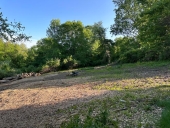
 6
6




 4
4




Invasive plants are Earth's way of insisting we notice her medicines. Stephen Herrod Buhner
Everyone learns what works by learning what doesn't work. Stephen Herrod Buhner
 6
6




Zach Lynn wrote:Hello all,
This is my first post on Permies. We have about 5 acres of land in upstate New York right outside of Albany. There is an east facing slope with a roughly 20 to 25% grade.
Last year I was able to put a couple of fruit trees on contour across the hillside, but did not build a wail. This year I have an intention of planting around 20 to 25 fruit trees in approximately 3 to 4 rows down the hillside.
I have two questions. One. Although I did my order wrong, I’d like to still build the wails for the pre-existing fruit trees. I understand that the ace of the tree would be buried below the berm so I’m assuming I can either try to lift up the tree to the top of the berm or just have the bottom base of the tree buried in the topsoil.
More pressing, though, I am planting a mix of semi dwarf, fruit varieties of which they all have different canopy shapes. It would be a mix of apples, pears, cherries, plums, and nectarine. The spacing that I’ve read is that 15 feet on center (or ~4.5 m) and 20 feet between the rows (~6 m) is a safe bet for a majority of the semi dwarf varieties.
Since I’ll be digging about 600 feet of wail by hands, I’d like to start now so that I can plant in dormancy before the hard winter.
I’d like to know what your recommendations are seeing as the contour lines already have variable widths from row to row so do I map out the wails to the distance apart of the trees or do I map the wails out to the proper distance of wails based on the slope and the upper canopy layer of the tree traced back to the landscape?
The material overhead is very variable essentially says it depends on the type of soil (heavy clay) and the slope (25%) and the height of the mature tree (20 ft max).
Your thoughts would be greatly appreciated. Thank you.
“Practicing mutual aid is the surest means for giving each other and to all the greatest safety, the best guarantee of existence and progress, physically, intellectually, and morally.”
― Peter Kropotkin, Mutual Aid: A Factor of Evolution

 5
5





- Tim's Homestead Journal - Purchase a copy of Building a Better World in Your Backyard - Purchase 6 Decks of Permaculture Cards -
- Purchase 12x Decks of Permaculture Cards - Purchase a copy of the SKIP Book - Purchase 12x copies of Building a Better World in your Backyard
 2
2




 1
1






|
meow meow meow tiny ad meow meow
Learn Permaculture through a little hard work
https://wheaton-labs.com/bootcamp
|

